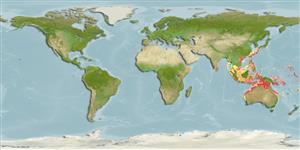Environment: milieu / climate zone / depth range / distribution range
Ecologie
marien demersaal; diepte 10 - 75 m (Ref. 11790). Tropical
Western Pacific: South China Sea to the Indo-Australian Archipelago (including Western Australia).
Grootte / Gewicht / Leeftijd
Maturity: Lm ? range ? - ? cm
Max length : 40.0 cm SL mannelijk / geslacht onbekend; (Ref. 9774); common length : 25.0 cm SL mannelijk / geslacht onbekend; (Ref. 9774)
Dorsale stekels (totaal) : 0; Dorsale zachte stralen (totaal) : 75 - 81; Anale stekels: 0; Anale zachte stralen: 61 - 64. Pectoral fin on ocular side with 11-12 soft rays.
Inhabits shallow water (10 m) on mud and sand bottoms of coastal zones (Ref. 9774) to a depth of 150 m (Ref. 9494). Feeds on small benthic animals (Ref. 9774). Caught mainly with prawn trawls (Ref. 9774). Marketed fresh and considered a good food fish.
Levenscyclus en paargedrag
Maturiteit | Voortplanting | Paaien | Eieren | Fecunditeit | Larven
Distinct pairing (Ref. 205).
Allen, G.R. and R. Swainston, 1988. The marine fishes of north-western Australia: a field guide for anglers and divers. Western Australian Museum, Perth. 201 p. (Ref. 3132)
Status op de Rode Lijst van het IUCN (Ref. 130435: Version 2024-2)
Gevaar voor de mens
Harmless
Gebruik door de mens
Visserij: commercieel
Tools
Speciale rapporten
Download XML
Internetbronnen
Estimates based on models
Preferred temperature (Ref.
123201): 24.6 - 28.8, mean 27.7 °C (based on 564 cells).
Fylogenetische diversiteitsindex (Ref.
82804): PD
50 = 0.5000 [Uniqueness, from 0.5 = low to 2.0 = high].
Bayesian length-weight: a=0.00724 (0.00338 - 0.01553), b=3.17 (3.00 - 3.34), in cm total length, based on LWR estimates for this Genus-body shape (Ref.
93245).
Trofisch niveau (Ref.
69278): 3.5 ±0.37 se; based on food items.
Weerstandsvermogen (Ref.
120179): Gemiddeld, minimale populatieverdubbelingstijd 1,4-4,4 jaar (Preliminary K or Fecundity.).
Fishing Vulnerability (Ref.
59153): Moderate vulnerability (39 of 100).
